#A CHRISTMAS CAROL (1951)
Explore tagged Tumblr posts
Text






A Christmas carol is my all time favourite Christmas story ❤️ it’s so nostalgic and classic, it’s not Christmas without it and these are my favourite adaptations I watch every year 🥰🎄👻 I’ve also added the man who invented Christmas as even though technically it’s not A Christmas carol I still love that it’s about the making of it ❤️
#my posts#Scrooge#scrooge 1951#a Christmas carol#a Christmas carol 1951#Alastair sim#barbie in a christmas carol#the muppet christmas carol#the muppets christmas carol#muppet christmas carol#Disney a Christmas carol#a christmas carol 2009#Mickey’s Christmas carol#Mickeys Christmas carol#the man who invented Christmas#charles dickens#Christmas#Christmascore#christmas core#i love christmas#christmas movies#christmas time#christmas love
27 notes
·
View notes
Text

Alastair Sim as Ebenezer Scrooge in Scrooge (1951)
Watercolors on Paper, 8.5" x 11", 2024
By Josh Ryals
#alastair sim#scrooge#ebenezer scrooge#scrooge 1951#a christmas carol#a christmas carol 1951#charles dickens#original art#portrait#painting#watercolors#fan art#josh ryals#joshua ryals#josh ryals art#joshua ryals art#joshryalsart
8 notes
·
View notes
Text
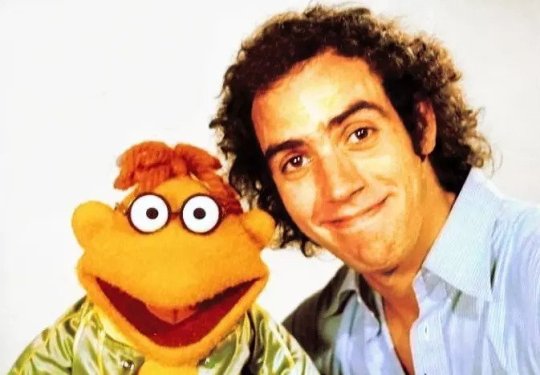
Richard Hunt (deceased)
Gender: Male
Sexuality: Gay
DOB: 17 August 1951
RIP: 7 January 1992
Ethnicity: White - American
Occupation: Puppeteer
Note: Because he was too ill with AIDS to do so, Hunt was the only Muppet Show puppeteer who did not return for The Muppet Christmas Carol, which is dedicated to his memory as well as that of Jim Henson.
#Richard Hunt#Muppet Christmas Carol#lgbt history#gay history#lgbt#male#gay#1951#rip#historical#white#puppeteer#hiv#popular#popular post#200
442 notes
·
View notes
Text

1951 Alastair Sim as Ebenezer Scrooge in "A Christmas Carol"
#alastair sims#ebenezer scrooge#a christmas carol#my favourite scrooge#1951#1950s#1950's#50s#vintage#retro#classic movie digest#facebook
28 notes
·
View notes
Text
fun fact i have discovered about the 1951 Scrooge movie
in the scene where scrooge meets jorkins for the first time he says he's starting a new company. scrooge later joins this company after jorkins offers him a job. marley is working there.
later, in the scene where jorkins is embezzling (the scene) they say the company has been in business for 17 years. this would be the company jorkins was starting. the year is 1836, it's seen on a book right before this, so scrooge + marley have been coworkers here for 17 years. in this scene they take over the company.
in the next scene, Past says "Jacob Marley worked at your side for eighteen years." A source I found implies that they're meant to be 21 in the scene where they meet. 21 + 18 = 39.
Marley was only 39 when he died, the same age as Michael Holdern when he played him.
Marley was only 39, and they were only in business independently for one year. one year at most, depending on how long marley was dying.
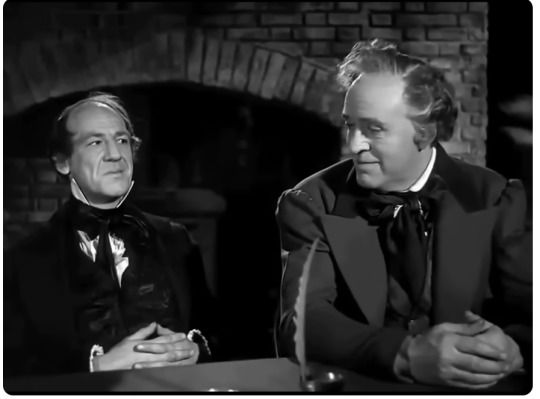
whatever these two were to each other, they only had a year in business together.
and that's fucking sad
#jacob marley#ebenezer scrooge#a christmas carol#scrooge 1951#me and vincent were losing our shit when we mathed the math#scrooge x marley#such a fucking waste of life and love#pathetic old gays
68 notes
·
View notes
Text
Christmas Carol-cember, Day 1
Ever since Charles Dickens published “A Christmas Carol” on December 1843, it has become a staple of the Christmas season.
From public readings to performances on the stage right up to the early inception of film in the 20th Century, it’s as much a cornerstone of the festive season as much as St Nick is. So with the advent of 20th Century, a new format of media known as cinema was able to take the story to new heights and explore elements that Dickens possibly could not have imagined within the limitations of his time and the thinking of that day.
So to start this month off properly, I figured, what better way to begin a month that explores the story of A Christmas Carol than with the film that is regularly ranked as being one of the best versions of the story, Brian Desmond Hurst's 1951 UK adaptation simply titled “Scrooge."
But most people just call it “The Alastair Sim Version.”

I won’t go into the story synopsis as I think it’s pretty well-known at this point, so instead, I want to touch on what it is about this film that gives it the reputation of being so beloved.
The first reason is that, for an adaptation, it adds more to the story than what it takes out. This works to its advantage by being able to explore elements of Scrooge’s backstory that are not covered in the original novel. For instance, this film allows us the viewer to see Scrooge’s business dealings with Jacob Marley, their cut throat practices that results in shutting down Fizziwig and enriching themselves financially. These story changes provides visual and emotional clarity that allows for us, and by extension Scrooge, to recognize how cruel his past has made him.
The other is it’s leading man, Alastair Sim.
Alastair Sim began his acting career in his 30s, after his time in the British military where he fought in World War I, where he honed his craft with Shakespearean performances on stage but occasionally dipping into film roles during the 1950s.
Alistair Sim was what one calls “a Character Actor.” Someone who takes the time to understand the character presented to them in a script; their quirks, their lines, their emotional state, and to embody them as soon as the director calls action.
And Alastair Sim, with no exaggeration, took that challenge and delivered a knockout performance.
For all the scenes that are built upon from it’s original source, Sim gives these scenes the emotional weight that is called for, while adding some truly subtle quirks that feel directly connected to the character.
The way he sneers when a tavern owner tells him bread will cost extra and he coldly tells him off.
The way he tries to be in control while terrified to see the ghost of Jacob Marley.
The way his faced body is wracked with heartache to see his ex-fiance is genuinely happy to work with the poor and sick while he remains empty and alone.
Even when he changes by the film’s end and he has been given another chance, he is bubbling with ecstasy that you would think he HAD gone crazy.
But my favorite subtle moment comes from the end.
After playing his prank on Cratchit and promising to support him and his family and sends him off to get more coal for the fire, there’s a moment as he chuckles where his smile flattens and he says “I don’t deserve to be happy” before he breaks into chuckles again and shifts back to positivity.
Almost as if a part of his old mean self lingered and tried to make a return before it was pushed back down by the newfound joy he discovered.
To put it bluntly: Alastair Sim is not playing Ebenezer Scrooge.
He’s playing an old, bitter, selfish and deeply traumatized man whose name is Ebenezer Scrooge.

And that difference in how he approached the role is key to why his performance, again and again, is highly ranked by fans as well as other actors. Much to the point that his performance has become the gold standard of how this performance is to be played.
Whether it’s a school play or a local theater production; every actor since this film has been trying to recapture that magic that Alastair Sim delivered in black and white.
This is a very good adaptation of the Charles Dickens story and well worth checking out. It might be one of the best to explore its character with added emotional weight that is carried by a star-making performance from Alastair Sim. It’s pacing is a tad slow, but when you have a performance this compelling, you almost don’t think about it as he draws you in.
“Scrooge” can be streamed on Tubi.
Next time, we look at a performance of Scrooge from another character actor, but one from the 1980s...

8 notes
·
View notes
Text
Happy Pride Month to the gayest exploiters 🏳️🌈
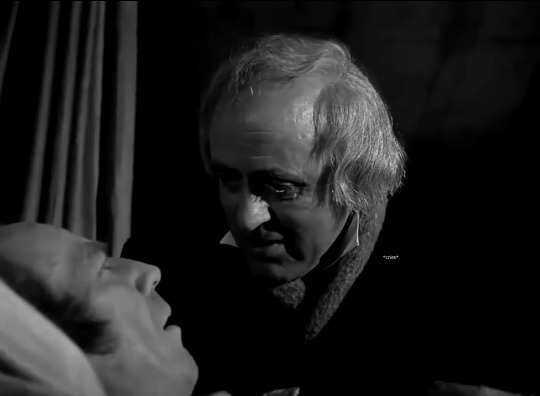
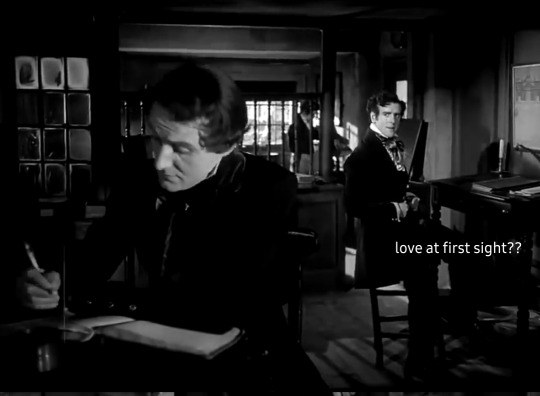
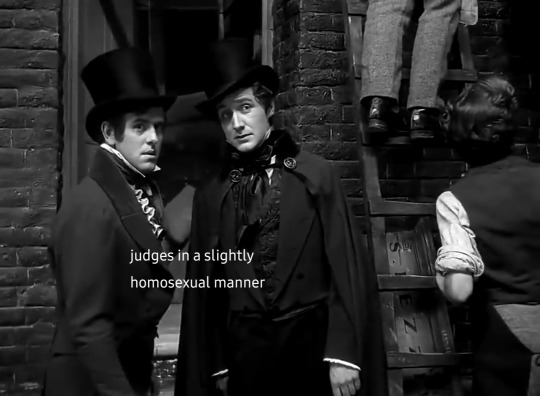
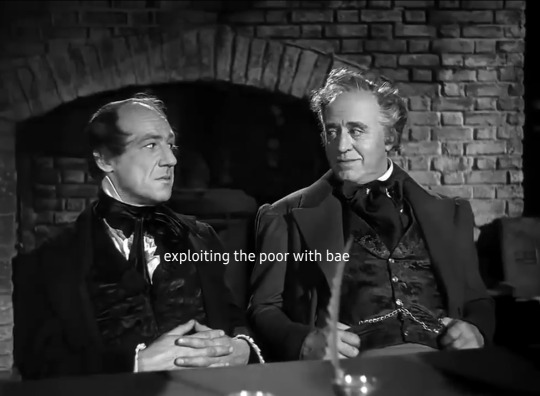
#pride 2023#There is no way the tension between them wasn't intentional though that's all I can say#a christmas carol#Scrooge 1951#jacob marley#ebenezer scrooge#scrooge x marley#I wish gay people were real
100 notes
·
View notes
Text
As I've been rewatching the different film versions of A Christmas Carol this year, I've been noticing something that I didn't even notice last year as I reviewed them for A Christmas Carol Holiday Season. Without changing the fundamentals of the story, different versions bring out different aspects of Scrooge's character arc.
It's similar to the phenomenon I've noticed in different screen and stage adaptations of fairy tales. For example, the way some versions of Cinderella are about the value of kindness, others are about never losing hope in the face of adversity, others about an outcast finding acceptance and love, others about an abuse victim discovering her own self-worth and inner strength, etc.
I suppose A Christmas Carol is a modern literary fairy tale, so it's no surprise that different adaptations find very different meanings in it.
For example:
Alastair Sim's 1951 Scrooge was once a good-hearted young idealist, but due to various external factors – his lonely childhood, his beloved sister Fan's death, the corrupt Mr. Jorkin replacing Fezziwig as his employer and mentor, and finally the loss of his fiancée Alice – he gradually came to view the world as a "hard and cruel place." So he steeled himself against it by turning cold and ruthless. The ghosts' job is to show him that the world isn't as cruel as he thinks it is; to remind him of all the kind, caring people both from his past and in his present, and to show him that kindness is the real solution to human suffering, while hardening himself has only caused and will cause more suffering, both for others and for himself.
Albert Finney's 1970 musical Scrooge is less icy than Sim's and more of a bitter, misanthropic workaholic who's forgotten how to appreciate the joys of living. Due to his lonely, awkward youth and the shattering loss of his fiancée Isabel, he declares "I hate life because life hates me!" and regards other people as leeches and fools, while seeing himself as a fine, upstanding gentleman forced to put up with them. The ghosts' job is to snap him out of his self-delusion and self-pity, and to teach him to joyfully live life to the fullest – which includes spreading kindness and cheer to others as well as enjoying himself – while he still can. A sharp reminder of his own mortality ensures that he learns the lesson.
For Michael Caine's Scrooge in The Muppet Christmas Carol, the emphasis is more on the lack of love in his life. Because he was neglected as a child and taught only to value business by Sam the Eagle his stern schoolmaster, he's never quite understood human bonds, and when he had one bright, shining chance for a different life through his love for Belle, he let it slip away. As a result, years of loneliness have turned him harsh and cold. The ghosts' job is to teach him the importance of love – both personal love of family and friends and more general love for his fellow Muppets and man – and to force him to admit how unhappy he is being alone with no one to love or to love him, breaking his heart until he changes.
I haven't managed to rewatch George C. Scott, Patrick Stewart, et al this year. But since the Christmas season technically lasts until January 6th, I plan to rewatch them, and I'm sure I'll find similarly unique spins on Scrooge's character arc.
All of these approaches are valid. They all draw on aspects of Scrooge's journey in the book. But each approach adds to the unique identity of each adaptation.
@ariel-seagull-wings, @cliozaur, @warrioreowynofrohan, @bliss-bliss-bliss-bliss
#a christmas carol#adaptations#ebenezer scrooge#character arc#characterization#scrooge 1951#scrooge 1970#the muppet christmas carol#alastair sim#albert finney#michael caine#fictional characters
37 notes
·
View notes
Text
Watching the 1951 version of "A Christmas Carol" and I'm literally agape.
"Ebenezer, promise me, you'll take care of my boy."
HE SEES HER DIE?
YOU DIDN'T HAVE TO DO THAT.
I mean, from a storytelling perspective, I adore it. But from a heartstrings angle, OUCH.
24 notes
·
View notes
Text
It was his own room. There was no doubt about that. But it had undergone a surprising transformation. The walls and ceiling were so hung with living green, that it looked a perfect grove; from every part of which bright gleaming berries glistened. The crisp leaves of holly, mistletoe, and ivy reflected back the light, as if so many little mirrors had been scattered there; and such a mighty blaze went roaring up the chimney as that dull petrifaction of a hearth had never known in Scrooge's time, or Marley's, or for many and many a winter season gone. Heaped up on the floor, to form a kind of throne, were turkeys, geese, game, poultry, brawn, great joints of meat, sucking-pigs, long wreaths of sausages, mince-pies, plum-puddings, barrels of oysters, red-hot chestnuts, cherry-cheeked apples, juicy oranges, luscious pears, immense twelfth-cakes, and seething bowls of punch, that made the chamber dim with their delicious steam. In easy state upon this couch there sat a jolly Giant, glorious to see; who bore a glowing torch, in shape not unlike Plenty's horn, and held it up, high up, to shed its light on Scrooge as he came peeping round the door. "Come in!" exclaimed the Ghost. "Come in! and know me better, man!" Scrooge entered timidly, and hung his head before this Spirit. He was not the dogged Scrooge he had been; and, though the Spirit's eyes were clear and kind, he did not like to meet them. "I am the Ghost of Christmas Present," said the Spirit. "Look upon me!"
Charles Dickens, A Christmas Carol
#reading this since we just watched the perfect Alistair Sim 1951 adaptation#a christmas carol#quotes
8 notes
·
View notes
Text

#Scrooge#A Christmas Carol#Alastair Sim#Mervyn Johns#Hermione Baddeley#Jack Warner#Kathleen Harrison#Michael Hordern#George Cole#Brian Desmond Hurst#1951
7 notes
·
View notes
Text
also while im christmas carol posting i might as well ask
what did these two have going on
because it was like advanced homosexuality

#a christmas carol#jacob marley#ebenezer scrooge#scrooge 1951#obsessed with them a la scrooge 1951#obsessed with the faint voice the marley ghost uses#obsessed with how the movie poses marley's death as The Last Awful Thing in the christmas past bit#like his death was the breaking point instead of belle leaving him
34 notes
·
View notes
Text
What, no It's a Wonderful Life? No A Christmas Carol with Alastair Sim? No A Christmas Story?
I feel like an archaist.
*slowly reaches for the popcorn*
18K notes
·
View notes
Text




W A T C H I N G
#SCROOGE (1951)#A CHRISTMAS CAROL (1951)#Alastair Sim#Mervyn Johns#Glyn Dearman#George Cole#Brian Worth#Michael Hordern#Francis de Wolff#Michael Dolan#Ernest Thesiger#Rona Anderson#Hermione Baddeley#CHARLES DICKENS#Horror#Christmas movie#Supernatural horror#WATCHING#Ebenezer Scrooge
1 note
·
View note
Text
"The world is on the verge of new and great changes, Mr. Scrooge. Some of them, of necessity, will be violent. Do you agree?" "I think the world is becoming a very hard and cruel place, Mr. Marley. One must steel oneself to survive it. Not be crushed under with the weak and the infirm."

#jacob marley#ebenezer scrooge#scrooge 1951#a christmas carol#look i know hes returning marleys energy here#but scrooge immediately taking marley's polite chat to the next level always gets me#youre making small talk with the new hire and he instantly starts talking about his nihilism
10 notes
·
View notes
Photo
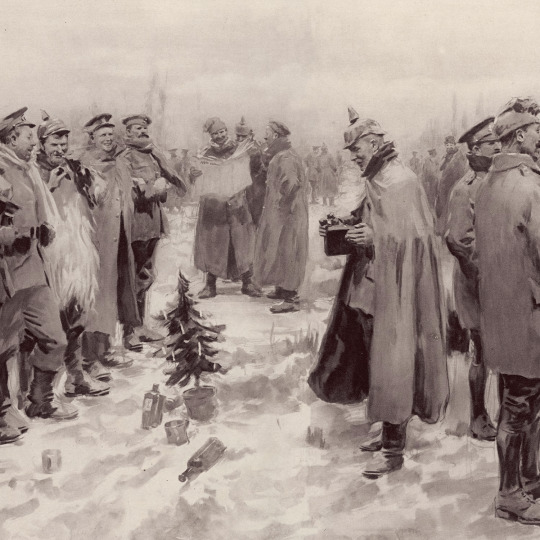
The Christmas Truce
The Christmas Truce of 1914 occurred on the Western Front during the First World War (1914-18). On Christmas Eve soldiers in the trenches spontaneously agreed to a ceasefire. Beginning with the singing of Christmas carols, the unofficial truce developed into soldiers meeting in no man's land, exchanging gifts, and even playing football together.
The Trenches in December
WWI began in July 1914 and quickly turned into a war of attrition, with frontline troops of the French, German, Belgian, and British armies subjected to the tribulations and horrors of trench warfare. The trenches were abysmal places: constantly flooded, thick mud everywhere, the men constantly subjected to shell fire, machine guns, and the stench of war. One brief respite came at Christmas time, the traditional season of goodwill to all. Pope Benedict XV (in office 1914-1922) had called for a truce on 17 December. The German government agreed to the ceasefire proposal, but the other nations in the war did not.
It seemed, then, that the only consolation and source of festive cheer for the troops on all sides would be their Christmas parcels sent from home. For British troops alone, well over 500,000 parcels were sent to the front in the weeks leading up to Christmas. Parcels from home included food, sweets, cigarettes, pipe tobacco, items of warmer clothing like socks and gloves, small gifts, and, perhaps from the more imaginative relatives, a few simple Christmas decorations. British and British Empire troops, in addition to charity and family parcels, also received a special gift tin from Princess Mary (1897-1965), daughter of King George V (r. 1910-1936). The embossed brass tin, one for every single soldier, contained a Christmas card, photographs of the king and royal family, pipe tobacco, a packet of cigarettes, and a tinder lighter. For those who did not smoke, there was a version with sweets and a pencil case. The king's photograph carried on the reverse the following message: "With our best wishes for Christmas 1914. May God protect you and bring you home safe" while the Christmas card read "With best wishes for a happy Christmas and a victorious New Year" (Brown, 124). Likewise, Wilhelm II, German Emperor (r. 1888-1918) gave a present of a cigar case and cigars to all German soldiers at the front. Wilhelm, German Crown Prince (1882-1951), gave everyone a souvenir pipe with his portrait on it.
Trenches were brightened up using candles, Christmas cards, holly and mistletoe scavenged from nearby forests, and perhaps a small Christmas tree or suitable substitute. German troops, in particular, received thousands of Christmas trees sent from home, and many were placed on the parapets of the trenches. On 23 December, as if in tune with the sentiment of the soldiers, mother nature contributed to the festive scene by ending the dreadful period of rainy weather that had bedevilled the troops since early November. Instead, snow began to fall upon many sections of the front line. The frost that night finally hardened up the mud. Next morning, as Rifleman Bernard Brookes noted in his diary, the effect was "a Christmas card Christmas Eve" (Brown, 60).
Princess Mary's Gift Tin, 1914
Imperial War Museums (CC BY-NC-SA)
Continue reading...
52 notes
·
View notes